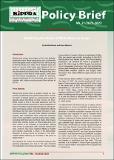| dc.date.accessioned | 2023-01-12T06:56:30Z | |
| dc.date.available | 2023-01-12T06:56:30Z | |
| dc.date.issued | 2022 | |
| dc.identifier.uri | https://repository.kippra.or.ke/handle/123456789/4027 | |
| dc.description.abstract | Staple food prices have been on the rise globally,
especially maize. Maize prices have risen consistently
since the global crisis in 2008 from Ksh 26.45 per kg
to Ksh 49.79 per kg in 2020. As of October 2022, the
price of 1kg dry white maize was trading at Ksh 72
per kg, a 44.6% increase from 2020. Staple grains are
very important for food security in Kenya as they form
a major part of the diet for most people, particularly
the low-income households. In 2020, for example,
cereals contributed 47.4% of the total daily supply of
calories, with maize providing most of the calories at
52.4%1.
Price Stability
Rising food prices have a greater impact on lowincome
households who spend most of their income
on food.2 A typical person in a low-income country
spends about two-thirds of their income on food.
White maize is one of the least expensive and the
most common food consumed by poor households in
Kenya. Therefore, high food prices reduce individuals’
food purchasing power, and has distribution effects
that favour the non-poor more than the poor in lowincome
countries. | en |
| dc.language.iso | en | en |
| dc.publisher | The Kenya Institute for Public Policy Research and Analysis (KIPPRA) | en |
| dc.relation.ispartofseries | PB/21/2022-2023 | |
| dc.subject | White Maize | en |
| dc.subject | Price Stabilization | en |
| dc.subject | Maize Affordability | en |
| dc.subject | Maize Demand | en |
| dc.subject | Food Production | en |
| dc.title | Policy Brief No. 21 of 2022-2023 on Stabilizing the Prices of White Maize in Kenya | en |
| ppr.contributor.author | Owino, Matilda & Waweru, Grace | en |

